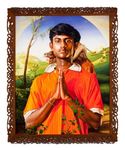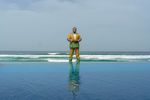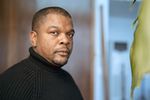Why Kehinde Wiley Listens to Audiobooks When He Paints
←
→
Page content transcription
If your browser does not render page correctly, please read the page content below
Wall Street Journal
Why Kehinde Wiley Listens to Audiobooks When He Paints
Jay Cheshes
17 February 2021
Why Kehinde Wiley Listens to Audiobooks When He Paints
The renowned painter on how he enters a “muscle-memory place” to create his
oversize portraits inspired by the Western canon
Image: Abdoulaye Ndao
As lockdowns began spreading around the world last winter, artist Kehinde
Wiley, 43, was working in Norway, shooting footage in the fjords for an upcoming show exploring the European
landscape and seascape traditions—an “epic painting and film project,” he calls it—opening late this year at the
National Gallery in London. “Gorgeous,” he says, of the Nordic locale, “but then, of course, the reality of the
pandemic started to make itself clear.”
With international borders closing, Wiley, who divides his time between studios in Brooklyn, Beijing and Dakar,
had a split-second decision to make. “I had to decide very quickly whether I would be returning to America or
coming to Senegal,” he says. He’s been holed up ever since at his complex, Black Rock Senegal, overlooking the
beach in Dakar. As places to quarantine go, it’s not so bad—complete with an infinity pool, a sauna, views of
crashing surf and an in-house team of chefs.
It’s also an artist residency, which Wiley opened in 2019 with the mission of allowing artists to create work
outside of a Western context. There were three artists on the property when Wiley arrived—German-Ghanaian
mixed-media artist Zohra Opoku, Nigerian writer Kelechi Njoku, and American painter Devin B. Johnson, all of
whom were originally scheduled to stay on for a few weeks. They wound up sequestered together for months.
“We relied a lot on each other,” Wiley says, “socially, physically. We were on real lockdown…. We were on campus,
working, discussing things, critiquing each other’s work.”
Image: Kehinde Wiley, Barack Obama, 2018, Oil on canvas, 84h x 58w in.
Photo: Kehinde Wiley, Barack Obama, 2018. © Kehinde Wiley. Courtesy Of The National
Portrait Gallery, Smithsonian Institution. The National Portrait Gallery is grateful to the
following lead donors for their support of the Obama portraits: Kate Capshaw And
Steven Spielberg; Judith Kern And Kent Whealy; Tommie L. Pegues And Donald A.
Capoccia.
One of six siblings raised by a single mom in South Central Los Angeles, Wiley began
his art education with a summer program at the Los Angeles County High School for
the Arts when he was 11 years old. He reached a new level of international acclaim three
years ago when his official presidential portrait of Barack Obama debuted at the Smithsonian in Washington,
D.C. But most of his models are unknowns—young Black men and women street-cast in American cities and
inserted into monumental paintings inspired by artists such as Diego Velázquez, John Singer Sargent and Titian.
Posed heroically in classical style, wearing baseball caps, tank tops, Timberlands and sweats, they stand out
against brightly hued backdrops. His fans include Beyoncé, Jay-Z, Alicia Keys and Swizz Beatz.
25—28 Old Burlington Street London W1S 3AN
T +44 (0)20 7494 1434 stephenfriedman.comWall Street Journal
Why Kehinde Wiley Listens to Audiobooks When He Paints
Jay Cheshes
17 February 2021
Wiley, who is now building a second Black Rock branch in Nigeria, will begin
welcoming a new crop of 15 artists-in-residence to Dakar this month (pending
vaccination rollouts and travel restrictions), including Nigerian-American
filmmaker Abbesi Akhamie and Congolese painter Hilary Balu. He says, “It’s
creating the dream residency that I’ve never had.”
Image: Abdoulaye Ndao
His process:
Wiley, whose work has taken on an increasingly global scope, casting subjects in Tel Aviv, Mumbai, Tahiti and in
Rio de Janiero’s favelas, typically travels with a film crew while street-casting. As 2020 started, he was looking
forward to casting for subjects on the streets of Dakar, among other places. For the past year he has focused
instead on the people around him. “Because of the pandemic we kind of had to work with the friends and family
of Black Rock,” he says, “There’s the guy who sells us all the plants for the garden here, the guy who captains
the boat when we go out fishing. Everybody wanted their portrait painted.”
His love affair with Africa:
He was 19 on his first trip to Africa in 1997, a journey in search of a father—Nigerian architect Isaiah D. Obot—
he’d never met. “It wasn’t the best initial meeting,” says Wiley. “For some reason I had this stick-to-it-ness and I
kept on coming back, banging myself on the head with this. And slowly we kind of built a rapport…. So I’ve been
for the last 20 years going back and forth to West Africa and now have this abiding relationship with the place.
My father passed away about a year and a half ago. I’m glad I took that step to get to know him. It was about him
certainly, but it was about much more than that; it was about the uncles and aunts and cousins and a sense of
myself existing within time and within history.”
His defining moment:
Go, his first monumental commission, debuted at the Brooklyn Museum in 2003, a series of ceiling panels
inspired by Giovanni Battista Tiepolo’s 18th-century frescoes. “It was the first chance for me to do something as
big and the first major work of my career,” he says. “And so I sort of wanted to announce
the start of my career by calling it Go—like, ‘Let’s get going!’ ” This January he unveiled a
follow-up of sorts to that piece, a stained-glass version of Go, inside New York’s new
Moynihan Train Hall at Penn Station. “All of these years later I kind of wanted to have a
closing of that circle and a return to that space.”
Image: Kehinde Wiley, Nandikesvara, 2010, Oil on Canvas, 45h x 36w. Photo: Kehinde
Wiley, Nandikesvara, 2010 © Kehinde Wiley. Courtesy of Galerie Templon, Paris.
His rituals:
He often paints while listening to audiobooks such as The Prophets by Robert Jones, Jr. “You can literally just
disappear into the narrative,” he says. “Then the painting becomes something that’s strangely almost out of body.
You spend less time concentrating on, Am I getting this color right? Is this brushstroke right? You kind of enter
this muscle-memory place: You’re feeling the painting rather than over-intellectualizing it.”
His collaborations:
In advance of the 2010 soccer World Cup in South Africa, Wiley partnered with Puma on apparel and shoes and
on portraits of star West African players. His 2012 collaboration with then-Givenchy designer Riccardo Tisci
produced dresses and paintings inspired by works Wiley picked out during a walk through the Louvre together.
“It used to be frowned upon for fine artists to do these kinds of engagements,” he says. “I think now we’ve kind
of gotten rid of this artificial high-low [divide].” Up next, an understated Centurion card for American
25—28 Old Burlington Street London W1S 3AN
T +44 (0)20 7494 1434 stephenfriedman.comWall Street Journal
Why Kehinde Wiley Listens to Audiobooks When He Paints
Jay Cheshes
17 February 2021
Express featuring his signature botanical print. “I think if the vibe is there, if it’s something that works, I’m all for
it,” he says. “But I try to find things that don’t interrupt the flow of what I’m trying to say.”
Image: Kehinde Wiley, Le Roi a la Chasse, 2006, oil on canvas, 96h x 72w in.
Photo: Kehinde Wiley, Le Roi A La Chasse, 2006 © Kehinde Wiley. Courtesy of Sean Kelly,
New York.
His latest shows:
Wiley’s landscape-themed show of new work opens in London toward the end of the year,
in the National Gallery, among historic works by J.M.W. Turner and Claude-Joseph Vernet.
His image of Obama—featuring the president at eye level in an unbuttoned collared shirt and surrounded by
flowers from Kenya, Indonesia, Illinois and Hawaii that hint at his personal biography—will be presented
alongside Amy Sherald’s portrait of Michelle Obama for a year-long five-city tour in June, traveling across the
U.S. to places including the Art Institute of Chicago, the Los Angeles County Museum of Art and Houston’s
Museum of Fine Arts. “So much of my work is known for taking the common man and elevating them to the level
of aristocrats and kings,” says Wiley. As president, Obama was “the most powerful man in the world,” he says.
So “we went in a much more personal, poetic direction.”
Image: Kehinde Wiley, Napoleon Leading the Army Over the Alps, 2005, Oil on canvas,
108h x 108w in. Photo: Kehinde Wiley, “Napoleon Leading The Army Over The Alps”
(2005), Oil On Canvas, 108 X 108 inches (Brooklyn Museum, Partial Gift Of Suzi And
Andrew Booke Cohen In Memory Of Ilene R. Booke And In Honor Of Arnold L. Lehman;
Mary Smith Dorward Fund, And William K. Jacobs, Jr Fund; © Kehinde Wiley; Photo
Courtesy Brooklyn Museum)
25—28 Old Burlington Street London W1S 3AN
T +44 (0)20 7494 1434 stephenfriedman.comYou can also read























































